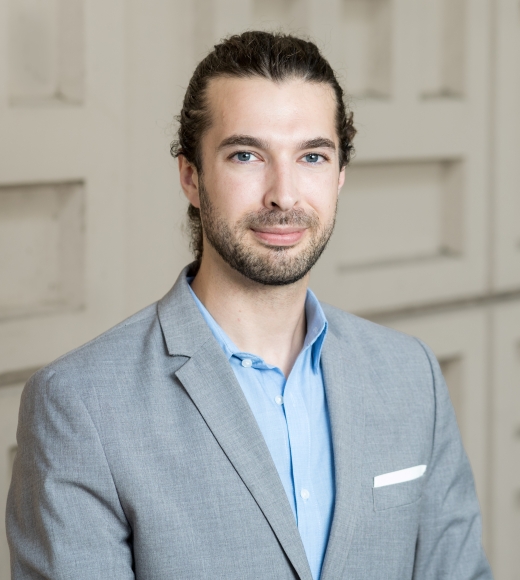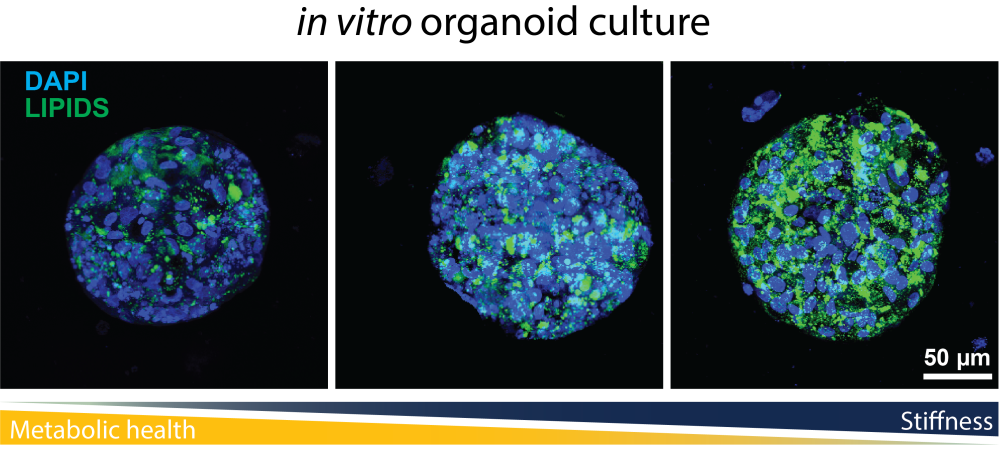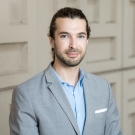The Tissues of Time: New Assistant Professor Aidan Gilchrist Explores How Biomaterials Can Reverse the Aging Process

The potential to turn back the biological clock may be inside us — or, more precisely, in the tissue surrounding our cells.
That's the inventive research focus of Aidan Gilchrist, a new assistant professor in the Department of Biomedical Engineering at the University of California, Davis, who believes there's an equal need to increase the quality of life as there is to extend it through medical advancements.
"We've literally pushed death back," Gilchrist said, thinking of the innumerable medical advancements helping humans live longer. "We now deal with all these unexpected age-related side effects, like a weakened immune system and a reduced ability to fight infections and disease. So, if we want to extend life, we also need to be able to be 'younger' during our lifespan as well."
In his new position, Gilchrist will establish a research program investigating the mechanisms behind cellular aging using tissue engineering and materials design principles. He will explore how hydrogels, a biomaterial consisting of a chain of molecules capable of absorbing a lot of water and behaving like human tissue, can reduce or reverse cellular aging and develop therapeutic strategies for treating age-related disorders.
"I've read sci-fi from the 1960s and 70s and 80s," Gilchrist said, "and a lot of it deals with preventing or stopping aging. It all seemed like fiction back in the day, but we are actually getting closer [to making those ideas a reality]."
Forming a Unique Matrix
Gilchrist's career began while wandering the halls of a chemical engineering building. He was reading the research posters hung on the wall to help him figure out what major to pursue when, suddenly, his path became clear.
"There was this super cool [poster] talking about healing diabetic ulcers, which happen on your extremities and never really heal, by taking the lining of a stomach and using that as a bandage with dramatic results. I thought that was the craziest and coolest thing I'd ever heard of, and I thought, 'Oh, I want to do that.'"
Gilchrist has since charted interconnections between chemical engineering, materials science, biology and regenerative medicine to empower his interest in the mending properties of tissue.
He attended graduate school at the University of Illinois, Urbana-Champaign, and earned a materials science and engineering doctorate in 2021. For his thesis, he designed a gelatin-based hydrogel that revealed critical insights into tissue engineering applications for regenerative medicine.
Gilchrist then sought a postdoctoral position at Stanford University, where he engineered matrices to study how the composition and stiffness of tissue environments contributed to challenges like the resistance of pancreatic cancer stem cells to chemotherapy. At the University of Massachusetts, Amherst, he authored an undergraduate thesis in chemical engineering with a similar interest: how breast cancer development depends upon stiffness and other cues from nearby tissue.
Since 2019 he has published nine peer-reviewed papers, with four of those as first author. Editors at Integrative Biology and Advanced Healthcare Materials have each selected one of his first-author studies as a cover image, signaling the high impact of his early-career research. In addition, Gilchrist received a provisional patent for a hydrogel system he co-invented at Stanford, further grounding his research program's immense promise.
Reversing the Tissue of Time
Tissue is the extracellular matrix, a non-living microenvironment that frames and physically supports cells. It regulates critical processes that inform functions like cell development and homeostasis, or the ability of a living organism to adapt to changing conditions with consistency.
Yet extracellular matrices age. Over time their ability to provide essential cellular and bodily functions decreases. This decrease leads to several age-related dysfunctions in the metabolic system, or the body's ability to turn molecules into energy. Metabolic dysfunctions can lead to disorders like chronic inflammation and type 2 diabetes.
Gilchrist believes that by engineering extracellular matrices with hydrogels, science can better understand how tissues influence age-related cell dysfunctions.

"As a biomaterialist, I can engineer specific properties into a hydrogel, and I can independently control things, such as the stiffness of the tissue and if there will be cell adhesion. I can independently tune each of these to investigate how [each aspect of the tissue] leads to a cellular response."
In other terms, he seeks to explore if an aged tissue environment causes cells to act aged and if a young environment causes cells to act young. He's interested in exploring this in bone marrow, where stem cells dwell in the body.
"Stem cells are at the apex of all tissue maintenance," Gilchrist said. "They can produce more cells in response to normal cell turnover and in response to injury and disease. By targeting stem cells, we can study aging at the very source."
Gilchrist has successfully demonstrated the ability of hydrogels to develop organoids, or three-dimensional tissue cultures capable of mimicking the processes of larger organs, such as the liver.
This ability to use hydrogels to mimic tissue and culture organoids shows immense potential for developing medical treatments capable of alleviating the effects of time on cellular processes. In the future, Gilchrist hopes that his biomaterial research leads to a pill that people can take to extend the youthfulness of their cells.
"Materials have far more properties than we talk about as a society. Once you begin going down that rabbit hole, there's so much within just a block of material, like a hydrogel. What's incredible is that cells can sense it, like there's a mechanism by which they are able to sense and respond to a material property on the order of, you know, microseconds and up to hours and days."
The Importance of Community
Gilchrist says he's come as far as he has in science because of an incredible support network. He believes that being community-minded is essential for a scientist.
"For most of us, 99 percent of science is failing and learning lessons from those failures, but in the moment, it feels like a failure," he said. "We all need to have a group of people that we feel supports and fosters us."
One of the things he's most excited about coming to UC Davis is to become a part of and promote the community on campus.
He aspires to launch a boot camp for first-year graduate students to foster community and to normalize asking for help. He is excited about mentoring students and connecting with faculty members on new research projects. He is also delighted to join his partner, Assistant Professor Scott McCormack, in the College of Engineering.
An extension of Gilchrist's community-oriented mindset is his engagement in many scientific organizations, including the Society for Biomaterials and the Biomedical Engineering Society. He is also an active member of Out in Science, Technology, Engineering and Math, or oSTEM, and the National Organization of Gay and Lesbian Scientists and Technical Professionals. He says he is excited to become involved with the UC Davis chapter of oSTEM, wanting to be a faculty liaison who supports students.
"Science is a collaborative effort in every regard, both in terms of the formal collaboration, and then also just in maintaining the scientist as a person."






